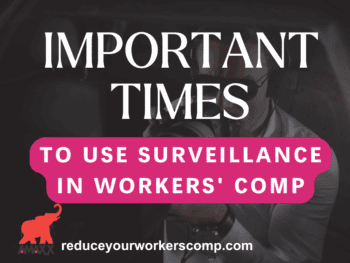
Fraud Perpetrated by Employees
Numerous examples and methods show how injured workers attempt to engage in fraudulent activities following an injury. Some warning signs include:
- The “Monday morning” injury;
- Unwitnessed injuries or events;
- Frequent changes in employment. Sometimes these involve economic lay-offs, strikes or seasonal employment;
- Injuries taking place in locations where the employee is not known to work; or
- Phantom injuries or incidents.
Click Link to Access Free PDF Download
“The 5Cs to Taking a Bulletproof Injured Worker Recorded Statement”
The list is endless. Other incidents of employee fraud include suspicious activities following a legitimate injury:
- Medical care and treatment irregularities. One common example of this is documented improvement of an employee’s condition followed by unexplained exacerbations or flare-ups;
- Medical providers with known connections to attorneys or rehabilitation processions;
- “Litigious” claimants with a known history of prior claims. Another warning is for claimants who have other family members receiving workers’ compensation or disability benefits; and
- Frequent changes in address and employment history.
Overcoming the challenges of these types of fraudulent activities can be difficult. Claim management teams should be aggressive in investigating these matters to the fullest extent possible.
Avoiding Fraud from Insureds
Workers’ compensation fraud is not limited to employees. It can also take place from clients served by the claim management team. As part of any claim handling activities, it is important to ensure employers are honest.
- Payroll Manipulation: Part of the methodology workers’ compensation insurance carriers use to calculate premiums is derived from payroll information provided by employers. This includes the number of employees or hours each employee works. Employers will manipulate the data they provide the insurance carrier to reduce their premium by not reporting this information accurately.
- Failure to Correctly Classify Employees: Not all persons who work for an employer are “employees” in the technical sense of the word. In some instances, these people are “independent contractors.” If a person falls into this classification, the employer in most instances will not have a legal requirement to provide workers’ compensation insurance. This is common in the construction industry or jobs involving seasonal employment.
- Experience Modification Avoidance: An employer’s “experience modification” is used to calculate the ultimate risk and serves as the basis by which a premium for workers’ compensation insurance is paid. TA company’s more accidents will impact this rating and result in higher premiums. This system encourages employers to provide a safe workplace and educate their workforce on accident avoidance.
In some instances, these safety measures are unsuccessful and an employer will pay high premiums to insure their workforce. To avoid these punitive measures, companies may use legal mechanisms to recreate themselves on paper as a new company to lower their rating. This practice and unethical and potentially fraudulent.
Conclusions
Fraud remains a cost driver in today’s workers’ compensation claims environment. It can come in many forms and is not limited to injured workers. To beat fraudulent activities, claim management teams need to be aggressive and sometimes take extra steps to prevail.
 Author Michael Stack, CEO Amaxx LLC. He is an expert in workers’ compensation cost containment systems and helps employers reduce their workers’ comp costs by 20% to 50%. He works as a consultant to large and mid-market clients, is a co-author of Your Ultimate Guide To Mastering Workers Comp Costs, a comprehensive step-by-step manual of cost containment strategies based on hands-on field experience, and is the founder & lead trainer of Amaxx Workers’ Comp Training Center, which offers the Certified Master of Workers’ Compensation national designation.
Author Michael Stack, CEO Amaxx LLC. He is an expert in workers’ compensation cost containment systems and helps employers reduce their workers’ comp costs by 20% to 50%. He works as a consultant to large and mid-market clients, is a co-author of Your Ultimate Guide To Mastering Workers Comp Costs, a comprehensive step-by-step manual of cost containment strategies based on hands-on field experience, and is the founder & lead trainer of Amaxx Workers’ Comp Training Center, which offers the Certified Master of Workers’ Compensation national designation.
Contact: mstack@reduceyourworkerscomp.com.
Workers’ Comp Roundup Blog: http://blog.reduceyourworkerscomp.com/
©2022 Amaxx LLC. All rights reserved under International Copyright Law.
Do not use this information without independent verification. All state laws vary. You should consult with your insurance broker, attorney, or qualified professional.














